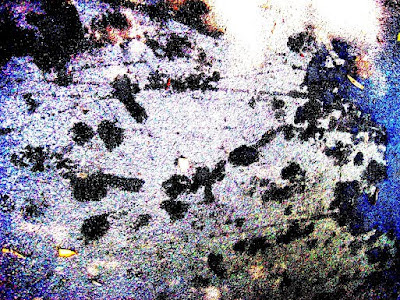Photo (c) Dovid Sears
Translation (bold) and Musings
(tentative) by Dovid Sears
To read Part II, click here.
We left off with Rebbe Nachman’s
statement that through truthfulness, we may draw God’s Providence upon ourselves,
and attain the awareness, in the very midst of this apparently dualistic world,
that all is one. Now the Rebbe returns to Rabbi Akiva’s warning to those who
would venture into the prophetic mysteries (see Part I) and interprets Rabbi
Akiva’s words according to the core ideas of this lesson.
This is [the meaning of] what Rabbi
Akiva said: When you reach the stones of pure marble, don’t say, “Water!
Water!” As it states, “One who speaks falsehood shall not endure before My eyes”
(Psalms 101:7) (Chagigah 14b).
“Stones of pure (tahor) marble
(shayish)”—this is the aspect of “after the Act”—i.e., after the act of creation—which
is “yesh”—“somethingness,” a word-play on “shayish.”
In this context, “yesh” might
also be rendered as “manifestation.” It is a fundamental belief of
Judaism that God created the universe ex nihilo, “something (yesh)
from nothing (ayin).” Another meaning of “yesh” is ego,
which reflects an inner split—an issue to which this lesson alludes is the
discussion of duality and non-duality. Rebbe Nachman discusses overcoming the
ego through hisbodedus in Likutey Moharan I, 52, which is the
very next lesson. Perhaps Reb Noson juxtaposed the two teachings for this
reason.
Then it is appropriate to use the
term “tahor” (pure), as we have said.
The next few lines make up one long,
complex sentence, so hang on:
If you wish that it should be as before
the Act [of creation], when it existed in potential, when “father and son were
as one,” as indicated by [the phrase]:
“When you reach the stones (avney)”—this
is the aspect of “father (av) and son (ben) as one,” which is the
aspect of Before Creation, when it was in potential, when everything was one—
That is, the word avney
(stones) may be homiletically understood as a combination of av (father)
and ben (son), which the Rebbe previously related to Creator and
creation…
“Shayish tahor” (“pure
marble”) is the aspect of “after the Act,” which is the aspect of manifestation
(yeshus) and purification (taharah)—if you wish to bring the “pure
marble” (duality) to the “stones” (non-duality)…
“Do not say, ‘Water! Water!’ ” This
is falsehood, as explained above. As it states: “One who speaks falsehood shall
not endure before My eyes” (Psalms 101:7).
One must overcome the illusion of
duality, which masks “True Reality,” which is the Divine Oneness. Then one may
be said to “endure before My eyes.”
Through falsehood one deflects God’s
Providence from himself, so that he is far from Oneness. However, through
truthfulness, God’s Providence rests upon him; through Providence, all is one,
as was the case before creation.
That is, through truthfulness one
“lives with God,” Who is “One, True, Good, and Holy,” as the Rebbe stated at
the beginning of the lesson.
Therefore, the reward of the World to
Come “no eye has seen it—only [that of] God alone’ (Isaiah 64:3; Berakhos
34b). Since everything will be one, there will not be an eye to see—that is, there will not be a
subject-object split—only “God alone.”
In the “World to Come,” which is also
a way of describing the transcendental plane, Divine Oneness prevails.
In conclusion, Reb Noson adds a
paragraph which integrates the key concepts of this lesson:
This is why falsehood damages the
eyes. Through falsehood one removes the “eyes” of God and damages the eyes,
which are the aspect of Providence, as explained above.
Thus, the removal of Divine
Providence, or “God’s eyes,” goes hand-in-hand with damage to the eyes of the
person—“both physically and spiritually,” as the Rebbe states in the beginning
of this lesson.
For falsehood stems from an
estrangement from Oneness; this is where impurity has its grasp—[impurity]
which is evil and falsehood. And because of this itself,—i.e., the estrangement from Oneness—by
means of falsehood one “damages” Providence and removes God’s watchfulness from
himself.
Through Divine Providence, all is
one, After Creation is like Before Creation; but through falsehood one
“damages” Oneness, since falsehood is distant from Oneness.
That is, the manifestation of Divine
Providence and the perception of Oneness are eclipsed.
Thus, one removes Providence through
falsehood, and causes a division, God forbid, between After Creation and Before
Creation, whence impurity primarily derives. However, through truth, which is
the paradigm of “entirely one, entirely good”—as the Rebbe stated earlier (see Part
II)—one elicits Divine Providence, and then all is one. For through Providence,
After Creation becomes reincorporated in Before Creation.
This is the explanation of “Rabbi
Akiva said…” And with this the discourse is integrated well, the beginning with
the end, and the end with the beginning, and likewise the middle; understand
this well.
The S’fas Emes (Rabbi Yehudah
Leib Alter of Ger), in his droshos on parshas Shoftim, observes
that the word “emes (truth)” is made of the first (alef), middle
(mem), and last (tav) letters of the Hebrew alphabet. Thus, the
very word for truth embodies the principle that truth must be consistent—as Reb
Noson suggests here, “the beginning with the end, and the end with the
beginning, and likewise the middle.”
With these parting words, Reb Noson
points out that like the word “emes,” Rebbe Nachman’s teaching on “emes”
is internally consistent. Thus, it intrinsically exemplifies the subject it
describes.















No comments:
Post a Comment